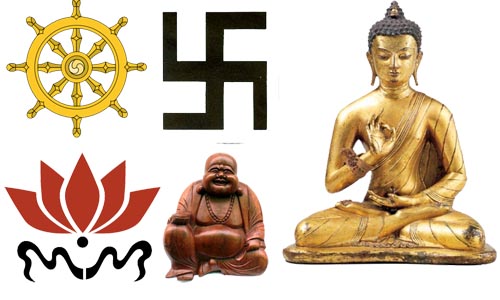
The Wheel of Life, Sign of Enlightenment, Lotus heart, Laughing Buddha and the central figure of Buddhist – Shakyamuni Buddha.
Shakyamuni Buddha, founder of Buddhism
Buddhism as Shakyamuni Buddha taught was simple and pure, but now one almost needs a doctorate degree to decipher all the different sects/types and practices available. The intellect has tried to understand the deep meaning of Shakyamuni Buddha’s teachings making them more complicated than our Maya world. The internet is full of intellectual dissections of Buddhism, please search if that’s what you are looking for. We shall supply a general more simple explanation of the main points. Fundamentally, Shakyamuni Buddha is not the only Buddha. The Buddha refers to the first, Shakyamuni Buddha, but Buddhism is made up of countless Buddha’s spread over many countries, cultures and era’s; which is why the teachings have become complicated. In some rituals the names of thousands or millions of Buddha’s are recited as mantra‘s. If you wish to know why Buddhism has become complicated, see here.
| Name: |
Gautama/Shakyamuni Buddha or Siddhartha Gautama Buddha |
|
Birth, Age, Death: |
480+ BC |
|
Nationality: |
Nepalese, known more as Indian |
|
Method/Religion started: |
Founder of Buddhism (Theravada, Mahayana, Vajrayana and Zen, etc) |
|
Holy book/teachings: |
Sutra’s (canonical scriptures), The Four Noble Truths – suffering is an ingrained part of existence and the origin of suffering is craving for sensuality, acquisition of identity, and annihilation. Suffering can be ended by following the Noble Eightfold Path (right view, right intention, right speech, right action, right livelihood, right effort, right mindfulness, and right concentration) |
|
Followers: |
Up to 500 Million |
|
Lifestyle requirements: |
Varies based on type, some require simple living and pure vegetarian diet; some require vegetarian just 2days monthly |
|
Form of practice: |
Varies – temple worship, offerings, meditation, good deeds |
|
Wiki (encyclopedia) link: |
http://en.wikipedia.org/wiki/Buddha |
“Do not believe in anything simply because you have heard it. Do not believe in traditions because they have been handed down for many generations. Do not believe anything because it is spoken and rumored by many. Do not believe in anything because it is written in your religious books. Do not believe in anything merely on the authority of your teachers and elders. But after observation and analysis, when you find that anything agrees with reason and is conducive to the good and the benefit of one and all, then accept it and live up to it.” In short, find a method you have affinity with and practice it well with all sincerity and devotion.
In essence, Shakyamuni Buddha taught deep inner meditation to find the truth about all things, to reach self-awareness, realization and eventually enlightenment. He was a no-nonsense guru with a sense of humor. When asked how to be happy, he said want what you have and not what you don’t have. His philosophy is very much like that, the obvious made obvious. Basically life is suffering caused by karma, to end suffering is the objective.
Buddhisim, the religion of Buddhists
Buddhists love numbers, following are a few to wet the appetite, but regrettably there are much, much more! One can spend a life-time trying to memorize and understand them all, better to meditate and understand the real dharma of Shakyamuni Buddha.
But behind its complexity caused by unenlightened theologians, it’s a very practical and powerful religion which is widely followed due to the many benefits. Buddhists have so many different sub-paths to choose from; easy baby-Buddhism which is like a do anything, eat anything type method to a very strict-Buddhism with vegetarian-diet and renunciate lifestyle and everything else in-between.
Five basic precepts:
- Abstain from killing living beings (from destroying/taking life)–or practice compassion.
- Abstain from taking the not-given (from stealing)–or practice charity.
- Abstain from sexual misconduct–or practice contentment.
- Abstain from false speech (from lying)–or practice truthfulness.
- Abstain from taking intoxicating drinks–or practice awareness and mental clarity.
3 Jewels of Refuge [Buddha, Dharma (the teachings), Sangha (the Buddhist community)]
3 higher trainings [Morality,Concentration,Wisdom]
4 noble truths [Suffering, Cause of suffering, Cessation of suffering, Eight-fold path to the cessation of suffering]
4 marks of Buddha’s teachings [Compound phenomena are impermanent, Ordinary phenomena are unsatisfactory, All phenomena are insubstantial (selfless), Nirvana is peace]
5 aggregates [Form,Feeling, Recognition, (Mental) formations, Consciousness]
6 Mahayana perfections [Generosity (giving), Moral discipline (ethics), Patience, Effort or energy, Meditative concentration, Wisdom]
10 Theravada perfections [Generosity, Moral discipline,Patience, Effort, Meditative concentration, Wisdom, Renunciation, Truthfulness, Loving-kindness, Equanimity]
8-fold path [Right view, Right intention, Right speech, Right action, Right livelihood, Right effort, Right mindfulness, Right concentration]
10 non-virtuous actions
-
Body (Killing, Stealing, Sexual misconduct)
-
Speech (Lying, Divisive speech, Harsh speech, Idle gossip)
-
Mind (Craving, Aversion, Delusion)
12 links of dependent arising [Ignorance, (Mental) formations, Consciousness, Name and form, Six Senses, Contact, Feeling, Craving, Grasping, Becoming, Birth, Ageing and death]
